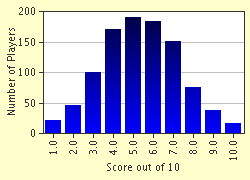Quiz Answer Key and Fun Facts
1. This is an acute intestinal infection caused by a bacterium. Its incubation period is typically 1-5 days. Symptoms include an excessive, painless watery diarrhea and usually vomiting. There may also be leg cramps. Severe dehydration and death can occur if not treated promptly. What is it?
2. This disease is spread from person to person through inhaling droplets from the throat of a contaminated person. Incubation period is from 2-5 days. It will usually attack the tonsils, pharynx, larynx and sometimes the skin. Complications can also affect the heart and peripheral nerves. This disease is potentially fatal even when properly treated. What is it?
3. The incubation period of this infectious disease is about 5 years and symptoms can take as long as 20 years to develop. It is not considered highly infectious but is spread through close and frequent contact with an untreated, infectious person. This disease attacks mainly the skin, nerves and eyes and will cause progressive and permanent damage. What is it?
4. Rabies is a terrifying viral disease that is spread through close contact with the saliva of an infected animal (usually through a bite). It affects the central nervous system and once symptoms start people do not recover and will die. In which of the following animals is rabies rarely found?
5. This infectious disease is contracted when people eat or drink water that is contaminated by the feces or urine of an infected person. There is a sudden onset of fever, a severe headache, nausea, anorexia, and a slow heart rate. It may also be accompanied by a hoarse cough and constipation or diarrhea. What is it?
6. This infectious disease kills 2 million people per year. It is growing and turning deadlier as it is becoming resistant to the drugs used to combat it. It spreads through the air when an infected person sneezes or coughs and a person only needs to inhale a small number of germs to become infected. What is it?
7. There is no cure for this highly infectious viral disease but vaccinations will prevent it. The virus enters the body where it multiplies in the intestines. Symptoms include fever, headache, vomiting , fatigue, stiffness in the neck and limb pains. One person in 200 will suffer irreversible paralysis. What is it?
8. This infectious viral disease usually has two phases. During the first 'acute' phase, there is fever, muscle pain, headache, shivers, no appetite, nausea and vomiting. After a few days the patient appears to be getting well only to enter the 'toxic' phase. Fever returns, the patient becomes jaundiced and experiences abdominal pain and vomiting. Bleeding can occur from the mouth, nose, eyes and stomach. Half of these patients will die within 10-14 days. What is it?
9. What is the common name for pertussis?
10. This infectious disease is also called 'guinea worm disease'. A parasite migrates through the body and eventually emerges through the skin, usually the soles of the feet. This is extremely painful. It is usually accompanied by fever, nausea and vomiting. What is it?
Source: Author
ballykissangel
This quiz was reviewed by FunTrivia editor
gtho4 before going online.
Any errors found in FunTrivia content are routinely corrected through our feedback system.


